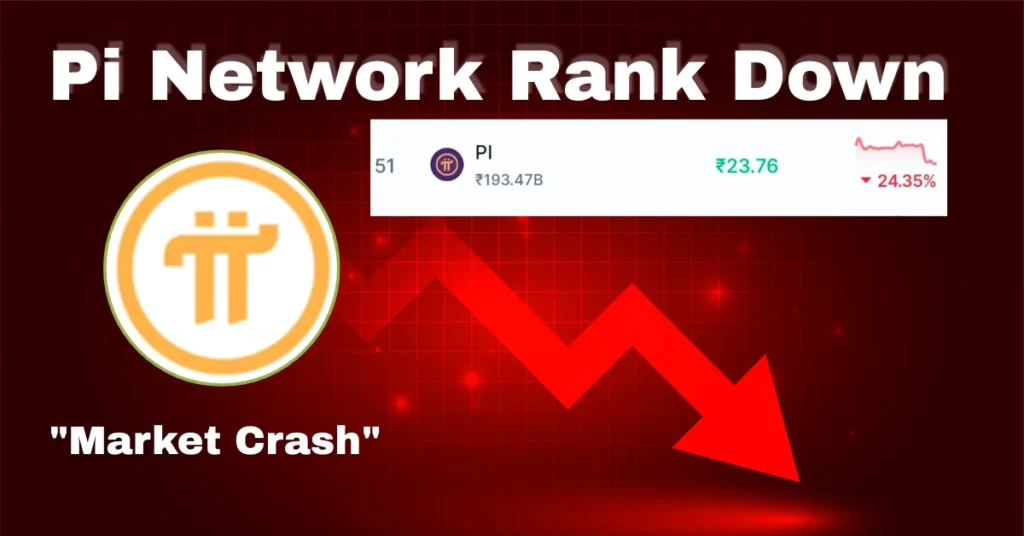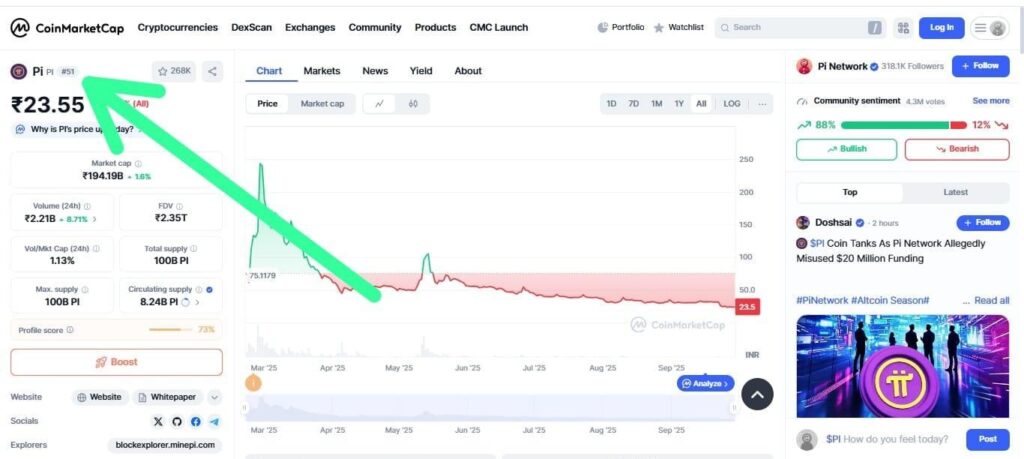
Table of Contents
ToggleIntroduction Pi Network CoinMarketCap?
Surprises are common in the crypto world, but Pi Network’s recent fall shocked the community. A few months ago, Pi Coin’s CoinMarketCap rank was 19, which was a massive achievement. But now, Pi Network has slipped below 50. This decline isn’t just a matter of numbers, but also a warning signal about investor sentiment and the project’s credibility.
In this article, we will explain in detail why this is happening with Pi Network.
Why did Pi Network’s ranking drop?
Why doesn’t the public receive these timely updates?
What could the future hold for Pi coin?
Earlier, I saw Pi Network in the top 20 on CoinMarketCap, but now it's in the bottom 50—a shocking fall that is angering the community.

Pi Network built a massive user base early on with its “Tap to Earn” model. Millions of pioneers mined daily, and the hype was so intense that the coin reached a top 20 market cap ranking.
But the current downfall has shaken investor confidence. A drop in coin market ranking from 19 to below 50 is no small matter. A drop in rank in crypto directly impacts project adoption and trust, and the Pi Network community has high expectations from Pi, but Pi Network is not doing its work properly. The team is also not providing coin updates that would make the community happy. I, too, have high expectations, but Pi Network has not yet given any good news that could pump its price.
Why did the Pi Network's market cap fall?
1. Impact of Supply Unlock and Circulating Coins
The Pi Network isn’t fully listed yet, but the circulating supply is gradually increasing. When more coins are unlocked and demand doesn’t increase as quickly, the price naturally falls. This is what is happening with Pi Coin at present. If it weren’t for the coins being unlocked, the Pi Network could have been even stronger – supply increased, but demand didn’t increase, which is why Pi Coin is crashing and losing its market share today.
2. Binance or Coinbase Top Exchange Listing Delay
The community’s highest expectation, and mine as well, was that Pi Coin would soon be listed on major exchanges like Binance or Coinbase. However, there is still no clear roadmap for listing, nor has there been any official confirmation. I check X daily on social media and official channels. This delay tested investors’ patience and was a strong reason for the decline in market cap, which led to the Pi Network crash.
3. KYC and Migration Process Slow
The Pi Network’s identity verification (KYC) and migration process is very slow. I also completed KYC. It took me 1.5 years to complete the KYC process, and after that, the mainnet migration process took me 6 months. My sub-success has been completed, but it’s still happening a little quickly. The system isn’t allowing users to migrate as quickly as they want. The result? Many pioneers aren’t able to freely trade their Pi. Frustration is building, and its impact is clearly visible on rankings.
4. Overall Downtrend of Crypto Market
The global crypto market is also in a correction phase. The decline in Bitcoin and Ethereum naturally puts more pressure on altcoins and unlisted tokens. Pi Coin also fell in line with the same market sentiment, which could be a reason for a correction.
Why is the public unaware?
The community is often confused as to why the ranking dropped. The answer to this question is not clearly available in the public domain.
Transparency issue: The Pi Network official team provides slow updates; I have also observed this, often releasing one update every six months to a year.
Community-based discussions: Most information is available on Reddit, X (Twitter), or Telegram.
Exchange absence: As long as there is no official exchange listing, it is difficult for users to understand the real-time price and market cap; hence, listing on big exchanges like Binance, Coinbase is mandatory.
Due to this, there is a delay in the general public understanding the exact reason.
What does the future hold for Pi Network?
Short-Term Outlook
Recovery for Pi Coin won’t be easy in the short term. Until exchange listings and migration speed up, the market cap is likely to remain under further pressure. Falling below rank 50 is a wake-up call for the community, as volatility in the crypto market is high, so any negative news is unlikely to have a significant impact quickly.
Long-Term Potential
The long-term story isn’t over yet. Pi Network still has:
Strong user base (millions of pioneers worldwide)
Unique “Tap to Earn” model
Community-driven adoption
If the team delivers a timely exchange listing and a transparent roadmap, Pi could return to the top 20–30 ranks. But if delays continue, people will lose interest, and the expectations they had from Pi Network will remain unfulfilled.
Is this decline the end or a new beginning?
Pi Network’s market cap decline is a reminder that hype and reality are two different things in crypto. Yes, the ranking has dropped, but that doesn’t mean the project is dead.
In crypto market history, many projects have fallen before and later recovered. Now, it all depends on the Pi team’s roadmap and execution. If they take timely action, this downfall could be a temporary correction. Otherwise, it will be difficult to recover community trust, and Pi Network will likely decline if there are no team updates or performance.
Final Note: The true test of Pi Network is yet to come. Long-term believers will need patience. However, in the short term, both volatility and risk will remain high.

Muddu – Crypto Enthusiast & Analyst
Muddu has been actively involved in the crypto world for more than 3 years, closely tracking Bitcoin, altcoins, and emerging blockchain projects. With hands-on experience in crypto trading, market analysis, and following global regulations, he simplifies complex crypto trends into easy-to-understand insights for readers.
Through FastCryptoBuzz, Muddu aims to bring honest, research-driven, and timely crypto updates that help readers stay ahead in the fast-moving digital asset space. His mission is to make crypto knowledge accessible to everyone – from beginners to seasoned investors.
“Crypto is not just about coins, it’s about building the future of finance.” – Muddu
